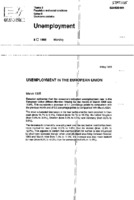Short-term trends. Unemployment. Unemployment in the European Union. 1995.5
| dc.contributor.author | Eurostat |
| dc.date.accessioned | 2020-12-02T13:28:47Z |
| dc.date.available | 2020-12-02T13:28:47Z |
| dc.date.issued | 1995-05-03 |
| dc.identifier.issn | 0252-9920 |
| dc.identifier.uri | https://ketlib.lib.unipi.gr/xmlui/handle/ket/3329 |
| dc.description | Multilingual in English and French. Text is faded/light in some places. |
| dc.description | http://aei.pitt.edu/id/eprint/86543 |
| dc.description.abstract | Eurostat estimates that the seasonally-adjusted unemployment rate In the European Union (fifteen Member States) for:ihe month of March 1995 was 10.8%. This represents a decrease of 0.1 percJntage points by comparison with the previous month and of 0.5 percentage points' by comparison with March 1994. I II The most substantial decreases in the last twelve months have occurred in Den-mark (from 10.7% to 9.2%), Finland (from 19.7~ to 16.5%), the United Kingdom (from 9.8% to 8.5%), Sweden (from 9.9% to 9.1%) and Germany (from 8.5% to 8.0%). /1 The decrease in community unemployment ove the last twelve months has been more marked for men (from 10.2% to 9.6%) t~an for women (from 12.8% to 12.6%). This appears to confirm that unemployMent for women is less influenced by short-term economic trends; when unemplo~~ent was rising between October 1990 and March 1994 from 7.5% to 11.3%, the increase was also more marked I' for men ~rom 62% to 10.2%) than for women (ffi 9.4% to 12.8%). |
| dc.format.extent | 16p. |
| dc.language.iso | en |
| dc.publisher | Eurostat |
| dc.subject | Employment/ Unemployment |
| dc.title | Short-term trends. Unemployment. Unemployment in the European Union. 1995.5 |
| dc.type | working document |
| dc.publisher.place | Luxembourg |

